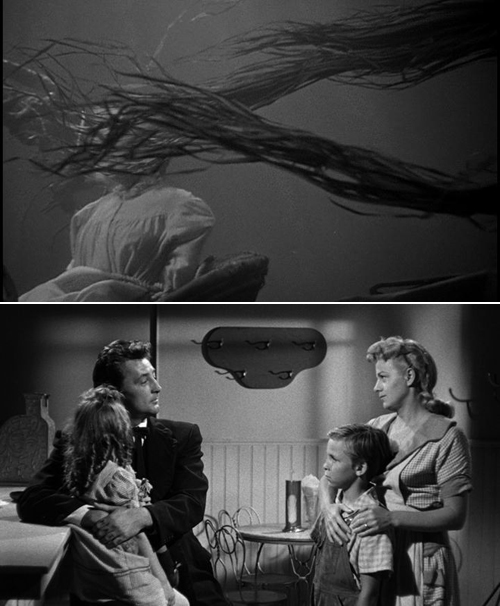La noche del cazador
Black Is To Move
Click here for the English version
Black Is To Move (1)↓ es un ensayo audiovisual sobre el movimiento, a todos los niveles. A primera vista, el movimiento puede parecer algo muy común en la existencia de cualquiera, pero en el universo cinematográfico se convierte en un elemento de gran importancia. Cuando lo observamos y tratamos de entenderlo, comenzamos fijándonos en su lado físico; sin embargo, tras él se esconde un aspecto psicológico fundamental. En ingles, por ejemplo, utilizamos el mismo verbo (to move) para referirnos a un desplazamiento físico y a una experiencia emocional. El movimiento es, pues, mucho más complejo de lo que parece.
En mi ensayo audiovisual decidí explorar este aspecto en relación a La noche del cazador (The Night of The Hunter, Charles Laughton, 1955). Black Is To Move presenta distintos niveles y concepciones del movimiento. En primer lugar, está la necesidad constante de los personajes de desplazarse, sea usando medios de transporte o a pie; el movimiento es abordado mediante un acercamiento más poético cuando lo encontramos en distintos elementos como el agua, el humo, la luz y las sombras; y, finalmente, todas estas imágenes conectan con los gestos y movimientos de bondad/maldad o amor/odio que pueblan la película. En mi ensayo, utilizo gestos que se tornan ambiguos, que son lo contrario de lo que parecen; hay un tránsito constante y siempre cambiante entre estas dos emociones opuestas y cada una de ellas trata de superar a su oponente. ¿Qué bando saldrá victorioso?

Además del movimiento interno del ensayo audiovisual, está el movimiento de la propia pieza. Aquí, he optado por buscar distintos patrones y formas del movimiento que expresan sus distintas dinámicas. Por ello, algunas partes del ensayo son más fluidas, mientras otras tienen un carácter de collage más evidente. La estructura externa de Black Is To Move es algo que me costó esfuerzo encontrar. Primeramente, desarrollé un plan meticuloso con ideas acerca de cómo editar la pieza pero, en cuanto me lancé a la práctica, me di cuenta de que, en realidad, iba a ser difícil que funcionara del modo en que lo había previsto. Decidí entonces prestar menos atención a mi plan original y moverme, paso a paso, al dictado de la propia pieza.
A lo largo del proyecto, sin embargo, sí que me mantuve aferrada a un concepto interno clave: explorar la dualidad bondad/maldad a partir de los contrastes de ciertas imágenes y movimientos (como los de las luces y las sombras). Más allá de eso, me permití ir adonde el filme me llevara. Cuando comencé a editar, di con el audio de una puerta que se encalla y, con él, creé un loop sonoro que imitaba el ruido de un tren desplazándose por las vías. Pero, este sonido, además de sugerir una imagen de movimiento, aludía también a la sensación de sentirse atrapado, y esto me ayudó a encontrar mi camino.
La realización de esta pieza, la búsqueda de una estructura tanto interna como externa, supuso un reto para mí. Finalmente, consideré más beneficioso para mi proyecto dejarme llevar, permitir que el filme y las ideas que iban surgiendo durante el proceso me guiaran. En retrospectiva, creo que este es uno de los aspectos más importantes de esta práctica: dejar que sea el filme el que te mueva (física y emocionalmente) en la dirección correcta.
Traducción al español: Cristina Álvarez López
Traducción al español © Cristina Álvarez López, junio 2015 | Texto original © Janina Bocksch, mayo 2015
![]()
(1)↑ El título hace referencia a una expresión usada en ajedrez cuando alguna de las piezas negras es forzada a moverse.
![]()
The Night of the Hunter: Black Is To Move
Click aquí para la versión en español
Black Is To Move (1)↓ is an audiovisual essay about movement, through and through. Movement, on the surface, may appear to be something normal in everyone’s existence, but in the cinematic world it is an element of great importance. When observing and understanding movement, we first focus on the physical part; but behind this also lies a large psychological aspect. We even have an expression that integrally connects our movements with our emotions, when we say ‘I am moved.’ Movement is therefore something much more complex than it originally seems.
In my audiovisual essay, I explore movement in Charles Laughton’s The Night of the Hunter (1955). Black Is To Move incorporates different levels and understandings of movement. First of all, we notice the characters’ constant need to move, in transportation media or by foot. Movement also takes on a more poetic approach within the essay, when it is found in various elements such as water, smoke, light and shadows. All these clusters of images are also related with the movements and gestures of love and hate, good and evil. In my audiovisual essay, I show gestures that are ambiguous in their form; they are not what they seem — there is a constant and ever-changing shift between these two important emotions, as we perceive that each one is trying to outdo the other. Which side is going to win?

Besides the internal movement within the piece, there is also the movement of the audiovisual essay itself. In Black Is To Move, I tried to find different patterns and forms to express the dynamics of movement. Therefore, some parts of the essay appear more flowing, whilst others have a collage-like character. The outer structure of this essay was something I struggled with at first. I began by developing a meticulous plan in regards to how I would edit the piece but, after actually starting to do it, I realised that it would be difficult for it to work out. I therefore decided to pay less attention to my original plan and move on with the piece step by step.
Throughout the project, however, I stuck to the key internal concept of exploring the duality of good and evil through contrasting images and movements such as light and darkness. But, other than that, I allowed myself to go where the film took me. When I was just beginning my work, I stumbled across the sound of a rattling door, whose audioclips I put together several times in a loop to create an effect which imitated the sound of a train on the tracks. This sound creates an image of train movement, but simultaneously alludes to a feeling of being trapped, and this helped me to make my way through the essay.
Editing Black Is To Move and figuring out how to structure the piece, on both an internal and external level, was quite challenging for me. In the end, I found it more beneficial to my project to just go with the flow, and follow wherever my ideas and the film led me. Looking back, I think that this is one of the most important aspects of the work: to simply let the film move you in the right direction.
Edited by Adrian Martin
© Janina Bocksch, May 2015
![]()
(1)↑ The title refers to an expression in chess signifying the need for a black piece to move.
